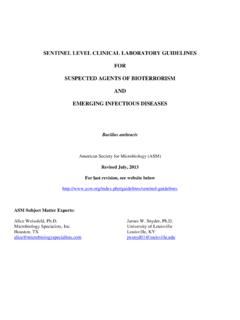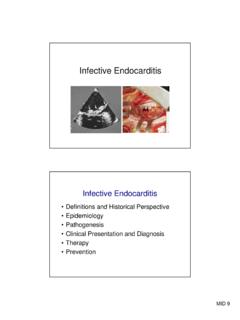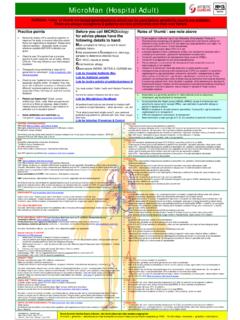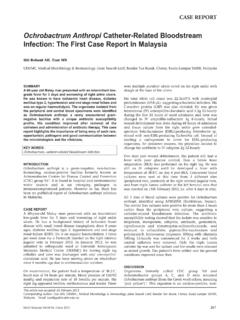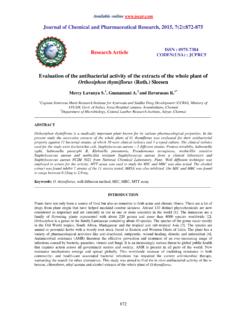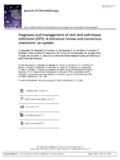Transcription of AN UNUSUAL CASE OF URINARY TRACT …
1 SUMMARYA erococcus viridans is generally a saprophytic bacterium. The bacterium has been reported as a rare pathogen in hu-mans and it is generally considered as a contaminant in clinical cultures. Infections caused by have been seldomlyreported. To date, there are only four reported cases of URINARY TRACT infections caused by worldwide, and here wepresent the fifth case involving a pregnant woman. A 30 year-old pregnant woman with normal signs of four months preg-nancy had the complaints of malaise, dysuria and increased urination frequency for the last three days. Also, she had tender-ness at the right part of abdomen during palpation.
2 The urine culture yielded the growth of >105cfu/ml of as theonly organism. The patient was orally treated with ampicillin because of pregnancy, which resulted in alleviation of the symp-toms over the next six days. To our knowledge, this is the first case of URINARY TRACT infection caused by in a preg-nant woman. Our report showes that even though is rarely associated with human infections, it could be a causa-tive agent of URINARY TRACT infection. Keywords:Aerococcus viridans, pregnancy, URINARY TRACT infection ZETA erococcus viridans n Neden Oldu u Nadir Bir riner Sistem nfeksiyonu Olgusu Aerococcus viridans genellikle saprofit oldu u bilinen bir bakteridir.
3 Bakteri insanlarda nadiren patojen olarak bildiril-mifltir ve genellikle k lt rlerde kontaminasyon olarak de erlendirilir. Literat rde bug ne kadar n neden oldu ud rt riner sistem infeksiyonu olgusu bildirilmifltir. Bu al flmada bir gebe kad nda saptanan beflinci olgu sunulmufltur. Son3 g nd r s k idrar yapma, idrar yaparken yanma ve k rg nl k flikayetleri olan 30 yafl ndaki 4 ayl k gebe kad nda normal gebe-lik bulgular ve bat n palpasyonunda sa da hafif hassasiyet saptanm flt r. drar k lt r nde saf k lt r halinde >105 remifltir. Hasta gebeli inden dolay ampisilinle tedavi edilmifl ve alt g nde flikayetleri kaybolmufltur.
4 Bilgileri-mize g re bu olgu, bir gebe kad nda g r len n neden oldu u ilk riner sistem infeksiyonu olgusudur. Bu olgu,insanlarda infeksiyona nadiren neden olmas na ra men, n riner sistem infeksiyonlar nda bir etken olarak d fl -n lebilece ini g s zc kler:Aerococcus viridans, gebelik, riner sistem infeksiyonuINTRODUCTIONA erococcus viridansis known as a saprophy-tic bacterium, and considered as a rare patho-gen in humans(5,9,11). has been repor-ted to comprise 5-10 % of the bacterial flora ofair and dust in occupied rooms. It is widely dis-tributed in the hospital environment and com-monly found on raw or processed vegetab-les(5,6).
5 Be found in very smallnumbers in the upper respiratory TRACT and onthe skin of healthy persons. The bacterium is ge-nerally considered as a contaminant in clinicalcultures(11).AN UNUSUAL case OF URINARY TRACT INFECTION CAUSED BYAEROCOCCUS VIRIDANSM eryem ET N*, Sabahattin OCAK**, Devrim ERTUN ** Mustafa Kemal University Medical Faculty, Department of Microbiology and Clinical Microbiology, HATAY-TURKEY** Mustafa Kemal University Medical Faculty, Department of Infectious Diseases and Clinical Microbiology,HATAY-TURKEY** Mersin University Medical Faculty, Department of Gynecology and Obstetrics, MERS N-TURKEYC orresponding author: Sabahattin Ocak.
6 Mustafa Kemal niversitesi T p Fak ltesi, nfeksiyon Hastal klar ve Klinik MikrobiyolojiAnabilim Dal , HATAY-TURKEYP hone: (0326) 214 26 36e-mail: of receive: , date of revision: Derg 2007;21(1):65-6765 Aerococci appear to be of low virulenceand may be normally pathogenic only in pati-ents with vulnerable conditions. associated with some human infectionsincluding bacteremia, septic arthritis, infectiousendocarditis, meningitis, URINARY TRACT infection(UTI), osteomyelitis, and wound infec-tion(2,5,9,11).To our knowledge, there are three cases ofUTI caused by 1967(3), and a case ofUTI with bacteremia caused by an87 year-old male nursing home resident in 2004have been reported thus far(5).
7 Here we describenot only the fifth case of UTI caused by , but also the first case of UTI caused a pregnant woman. case PRESENTATIONA30 year-old pregnant woman, housewi-fe, was admitted to Education and ResearchHospital of Mustafa Kemal University, had complaints of malaise, dysuria and in-creased URINARY frequency for three days. Shehad no previous history of UTI or chronic illnessin the past 12 months. There was no history ofurinary catheterization or other genitourinaryprocedures. On examination, she had normalbody temperature, heart rate of 88 beats/minu-te, and blood pressure of 110/55 mm Hg.
8 Shehad a little right sensitiveness in abdomen pal-pation. Cardio-respiratory exam was unremar-kable. No other abnormalities were had normal signs of four months preg-nancy. She was using only a multivitamin pillowing to pregnancy. Laboratory investigations revealed the fol-lowing values: haemoglobin g/dl, leukocy-te count 11,300 cells/m3, platelets 319,000cells/m3, SGPT 12 IU/L and SGOT 20 IU/L,urea 16 mg/dl, creatinine mg/dl. Urinalysisshowed more than ten white mid-stream urine sample of the pati-ent was inoculated on Colombia agar + 5 % she-ep blood and eosine methylene blue agar (bioMe-rieux, Marcy I Etoile-France), and incubated at37 C for 24 h.
9 Bacterial identification was basedon biochemical method (API 20 STREP, bioMe-rieux, Marcy I Etoile-France). Gram stain, cata-lase, growth in % sodium chloride broth, es-culin hydrolysis, and pyrrolidonyl aminopepti-dase (PYR) tests were performed. Following theincubation of urine culture plates, >105 isolated as pure culture . The iso-late was negative for catalase, and positive forPYR and 40 % bile esculin reactions and for thegrowth in % sodium chloride. To determine the antimicrobial susceptibi-lity profile of the organism, disk diffusion met-hod was performed following the guidelines re-commended by CLSI (formerly NCCLS) fornonpneumococcal Streptococcuscategory(8).
10 Theresults showed that the isolate was susceptibleto vancomycin (30 mcg), cefoperazone-sulbac-tam (75+30 mcg), imipenem (30 mcg), ampicillin(10 mcg), and intermediate-resistant to amoxi-cillin-clavulanate (20+10 mcg), and resistant tocefotaxime (30 mcg), cefazolin (30 mcg), cefuro-xime (30 mcg), cipropfloxacin (5 mcg), and gen-tamicin (10 mcg). Because of pregnancy, the patient wastreated orally with ampicilline 500 mg tablet, fourtimes a day. Followed-up, she reported improve-ment in her complaints over the next six days,had normal urination and culture -negativeurine sample. a world-wide distribution,is mainly a pathogen of lobsters, and has rarelybeen involved as a cause of human infecti-ons(2,3,5,9).
